
The greenish yellow flowers are produced in panicles about 2-5" long. These flowers can be either unisexual (male or female) or perfect. Individual flowers are about 1/8" (3 mm.) across, consisting of 5 deciduous petals, an insignificant calyx that has been reduced to a flat disk, and the reproductive organs. Male flowers have 5 prominent stamens, while female flowers have a superior ovary with a short style. Perfect flowers have both types of reproductive organs. The blooming period occurs during late spring and lasts about 1 week. The flowers are quite fragrant. Fertile female flowers are replaced by berries that are arranged in panicles about 3-8" long. These panicles are usually wider near their bases than toward their tips. After they become mature during late summer or autumn, individual berries are ¼-½" across, globoid in shape, dark blue to black, and slightly glaucous. Each berry has a juicy interior with 2-4 small seeds. The flavor of mature berries varies from sweet to tart.
Cultivation: This woody vine prefers full to partial sun, moist to dry-mesic conditions, and soil containing loam, sandy loam, or some rocky material. It will also grow on clay soil if it is adequately drained. This vine can smother and even kill shrubs and small trees. Production of berries requires some exposure to sunlight.
Range & Habitat: The native Summer Grape is occasional to locally common in southern and central Illinois, while in the northern section of the state it is less common or absent. This map combines the distribution of both the typical variety of Summer Grape, as described here, and Vitis aestivalis bicolor (Silver-Leaved Grape), which is found primarily in NE Illinois. Habitats for Summer Grape include upland woodlands, sandy upland woodlands, typical savannas and sandy savannas, openings in bottomland woodlands, woodland borders, thickets, powerline clearances in wooded areas, areas along woodland paths, fence rows, limestone glades, and thinly wooded bluffs. Wooded habitats are dominated by various deciduous trees. Summer Grape prefers areas where there has been some history of disturbance such as wildfire, logging, etc., as it is intolerant of dense shade from overhead canopy trees.
Faunal Associations: The flowers are cross-pollinated by bumblebees (Bombus spp.), honeybees (Apis mellifera), long-horned bees (Eucera spp.), and probably other bees (Robertson, 1929). In addition to these floral visitors, many insects feed on the leaves, sap, wood, and other parts of Summer Grape and other wild grapes (Vitis spp.). These insect feeders include the larvae of long-horned beetles, leaf beetles, weevils, Scarab beetles (including Japanese Beetles), aphids, spittlebugs, leafhoppers, armored scales, treehoppers, the Grape Phylloxera (Daktulasphaira vitifoliae), mealybugs, thrips, the Giant Walkingstick (Megaphasma denticrus), and larvae of the following moths: Geometer moths, leaf blotch miner moths (Gracillariidae), shield-bearer moths (Heliozelidae), owlet moths (Noctuidae), Sphinx moths, and window-winged moths (Thyrididae). The Insect Table provides a more complete list of these insects. The abundance of insects that are found on wild grape vines is an important source of food for insectivorous songbirds. The ripe fruits of these woody vines are also an important food source for many kinds of birds, including: Tanagers, crows, sparrows, blackbirds, orioles, some warblers, woodpeckers, thrushes, vireos, wood ducks, and upland gamebirds (see Bird Table). These birds spread the seeds in the fruits far and wide. The leafy woody vines of wild grapes also provide excellent protective cover and nesting habitat for many kinds of birds. Narrow strips of bark from older vines are used as a nesting material for some species of birds.

Mammals also use Summer Grape and other wild grapes as a source of food and protective cover. This includes such mammals as the Domestic Goat (woody vines), White-tailed Deer (leaves), Gray Fox (fruit), American Red Fox (fruit), Virginia Opossum (fruit), Striped Skunk (fruit), Prairie Spotted Skunk (fruit), Raccoon (fruit), Fox Squirrel (fruit), and American Black Bear (fruit); see Blackmore (1998), Martin et al. (1951/1961), Sokala & Kirkpatrick (1973), and Beeman & Pelton (1980). The Eastern Box Turtle also feeds on the fruit of wild grape vines when they sprawl across the ground (Ernst et al., 1994).
Photographic Location: A powerline clearance and roadside along Busey Woods in Urbana, Illinois.

Comments: This is one of several native Vitis spp. (Wild Grapes) that can be found in Illinois. The typical variety of Summer Grape, as described here, can be distinguished from other wild grapes within the state by using the following two criteria: 1) the leaves often form lobes with deep narrow sinuses that have rounded bottoms, and 2) the lower surface of the leaves is covered with woolly appressed hairs that are dull white to light brown. Another variety, Vitis aestivalis bicolor (Silver-Leaved Grape), which is also native to Illinois, differs from the typical variety by having leaf undersides that are bright white, glaucous, and hairless. It is also more glabrous overall and often has bright red stems. Another wild grape, Vitis cinerea (Winter Grape), also has leaf undersides with woolly appressed hairs, but they are more dense and bright white (at least while young), and the leaves of Winter Grape never have deep lobes. Other species of wild grapes in Illinois have glabrous leaf undersides, or their leaf undersides have hairs along the veins only.